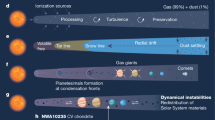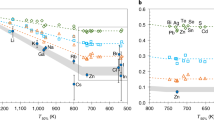Abstract
Arising from F. Albarède Nature 461, 1227–1233 (2009)10.1038/nature08477
It has long been thought that the Earth had a protracted and complex history of volatile accretion and loss1,2. Albarède3 paints a different picture, proposing that the Earth first formed as a dry planet which, like the Moon, was devoid of volatile constituents. He suggests that the Earth’s complement of volatile elements was only established later, by the addition of a small veneer of volatile-rich material at ∼100 Myr (here and elsewhere, ages are relative to the origin of the Solar System). Here we argue that the Earth’s mass balance of moderately volatile elements is inconsistent with Albarède’s hypothesis but is well explained by the standard model of accretion from partially volatile-depleted material, accompanied by core formation.

Similar content being viewed by others
References
Ringwood, A. E. Chemical evolution of the terrestrial planets. Geochim. Cosmochim. Acta 30, 41–104 (1966)
Wänke, H. Constitution of terrestrial planets. Phil. Trans. R. Soc. Lond. A 303, 287–302 (1981)
Albarède, F. Volatile accretion history of the terrestrial planets and dynamic implications. Nature 461, 1227–1233 (2009)
Allègre, C. J., Manhes, G. & Gopel, C. The age of the Earth. Geochim. Cosmochim. Acta 59, 1445–1456 (1995)
Wood, B. J. & Halliday, A. N. Cooling of the Earth and core formation after the giant impact. Nature 437, 1345–1348 (2005)
Touboul, M., Kleine, T., Bourdon, B., Palme, H. & Wieler, R. Late formation and prolonged differentiation of the Moon inferred from W isotopes in lunar metals. Nature 450, 1206–1209 (2007)
Palme, H. & O'Neill, H. S. C. in The Mantle and Core Vol. 2 (ed Carlson, R. W.) 1–38 (Elsevier, 2003)
Wiechert, U. et al. Oxygen isotopes and the Moon-forming giant impact. Science 294, 345–348 (2001)
Walker, R. J. et al. Comparative 187Re-187Os systematics of chondrites: implications regarding early solar system processes. Geochim. Cosmochim. Acta 66, 4187–4201 (2002)
Yin, Q. Z. et al. A short timescale for terrestrial planet formation from Hf–W chronometry of meteorites. Nature 418, 949–952 (2002)
Wasson, J. T. & Kallemeyn, G. W. Compositions of chondrites. Phil. Trans. R. Soc. Lond. A 325, 535–544 (1988)
Lodders, K. Solar system abundances and condensation temperatures of the elements. Astrophys. J. 591, 1220–1247 (2003)
Author information
Authors and Affiliations
Corresponding author
Ethics declarations
Competing interests
Competing financial interests: declared none.
PowerPoint slides
Rights and permissions
About this article
Cite this article
Wood, B., Halliday, A. & Rehkämper, M. Volatile accretion history of the Earth. Nature 467, E6–E7 (2010). https://doi.org/10.1038/nature09484
Received:
Accepted:
Published:
Issue Date:
DOI: https://doi.org/10.1038/nature09484
- Springer Nature Limited
This article is cited by
-
Late veneer and the origins of volatiles of Earth
Acta Geochimica (2022)
-
The Diverse Planetary Ingassing/Outgassing Paths Produced over Billions of Years of Magmatic Activity
Space Science Reviews (2021)
-
Water and Volatile Inventories of Mercury, Venus, the Moon, and Mars
Space Science Reviews (2018)
-
Editorial: Topical Collection on the Delivery of Water to Proto-Planets, Planets and Satellites
Space Science Reviews (2018)
-
Water in the Earth’s Interior: Distribution and Origin
Space Science Reviews (2017)





